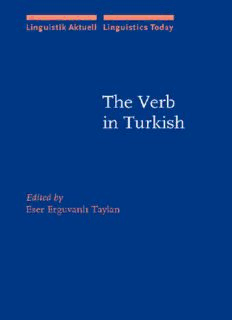
The Verb in Turkish PDF
Preview The Verb in Turkish
<ATSKSWVIUIDUEOZTIBYDOTEFLJWFHTECESHHCOOIEN"ETTRRTFI"DhG1O"""e5SLH4"0i"nTV">"g"eur"bi2s2ti0ikn"ATkutrukeilslh/L"inguisticsToday,Volume44" TheVerbinTurkish Linguistik Aktuell/Linguistics Today Linguistik Aktuell/Linguistics Today (LA) provides a platform for original monograph studies into synchronic and diachronic linguistics. Studies in LA confrontempiricalandtheoreticalproblemsasthesearecurrentlydiscussedin syntax,semantics,morphology,phonology,andsystematicpragmaticswiththe aim to establish robust empirical generalizations within a universalistic perspective. SeriesEditor WernerAbraham UniversityofCaliforniaatBerkeley UniversityofVienna RijksuniversiteitGroningen AdvisoryEditorialBoard GuglielmoCinque(UniversityofVenice) GüntherGrewendorf(J.W.Goethe-University,Frankfurt) LilianeHaegeman(UniversityofLille,France) HubertHaider(UniversityofSalzburg) ChristerPlatzack(UniversityofLund) IanRoberts(UniversityofStuttgart) KenSafir(RutgersUniversity,NewBrunswickNJ) LisadeMenaTravis(McGillUniversity) StenVikner(UniversityofAarhus) C.Jan-WouterZwart(UniversityofGroningen) Volume44 TheVerbinTurkish EditedbyEserErguvanlıTaylan The Verb in Turkish Edited by Eser Erguvanlı Taylan Bog˘aziçiUniversity JohnBenjaminsPublishingCompany Amsterdam(cid:1)/(cid:1)Philadelphia TM ThepaperusedinthispublicationmeetstheminimumrequirementsofAmerican 8 NationalStandardforInformationSciences–PermanenceofPaperforPrinted LibraryMaterials,ansiz39.48-1984. LibraryofCongressCataloging-in-PublicationData TheVerbinTurkish /editedbyEserErguvanlıTaylan. p. cm.(LinguistikAktuell/LinguisticsToday,issn0166–0829;v.44) Includesbibliographicalreferencesandindex. 1.Turkishlanguage--Verb.I.Taylan,EserErguvanlı.II.Linguistikaktuell;Bd.44. PL161.V47 2001 494’.355--dc21 2001037867 isbn9027227659(Eur.)/158811073(cid:3)7(US)(Hb;alk.paper) ©2001–JohnBenjaminsB.V. Nopartofthisbookmaybereproducedinanyform,byprint,photoprint,microfilm,orany othermeans,withoutwrittenpermissionfromthepublisher. JohnBenjaminsPublishingCo.·P.O.Box36224·1020meAmsterdam·TheNetherlands JohnBenjaminsNorthAmerica·P.O.Box27519·Philadelphiapa19118-0519·usa <ATSKSWV<"<"<"<"<"<"<"<"<"<"<"<"<"<"<"<"<"<"<"<"<"<"<"<"<"ggiissccssttnnkkoooonntssIUInnTUEaaoOeecciiiiooZoozzzzaaiiTI""nnyyhhzztt""cBYRRRRRRRRRRRR/AssttD>>kkkkrrTEFrr>>""""L"""""""""""JW""////////////""ooR>>>>F>>>>>H>>>>T>>EET>>>>""SGHHC>>RRRRRRRRRRRROOEEEEEEEEEEEEEE"ETATRRTTIEEEEEEEEEEEE"RDaG1"Gb""FFFFFFFFFFFF5SLH"4"FFFFFFFFFFFFl0tEei"onT">T"cg"o"u"fi2sD2cti0Ook"nCtAeINnkttFsuO"ell/LinguisticsToday,Volume44" Table of contents Introduction vii EserErguvanlıTaylan FiniteinflectioninTurkish 1 EnginSezer Anoteonmood,modality,tenseandaspectaffixesinTurkish 47 GuglielmoCinque Periphrastictense/aspect/mood 61 GerjanvanSchaaik Ontherelationbetweentemporal/aspectualadverbsandtheverb forminTurkish 97 EserErguvanlıTaylan Thereferentialpropertiesoftheimplicitargumentsofimpersonal passiveconstructions 129 MineNakipog˘lu-Demiralp Theauxiliaryverbolatthemorphology–syntaxinterface 151 AslıGöksel FunctionalprojectionsandtheirsubjectsinTurkishclauses 183 JaklinKornfilt On‘small’clauses,other‘bare’verbalcomplementsandfeature checkinginTurkish 213 A.SumruÖzsoy Turkishasanon-pro-droplanguage 239 BalkızÖztürk Nameindex 261 Subjectindex 265 <ATSKSWVIUITUEOZTIBYADTEFLJWRFHTEESGHHCOOEE"ETTRRITIn"DG1t"""r5SLH"4Eo0ii"nsdnT">"etug"rruco"ti2"Eiso2tri0nDgk"u"OvACaknItlNuıFeTlOl/aLyilnangu"isticsToday,Volume44" Introduction EserErguvanlıTaylan Bog˘aziçiUniversity WorkdoneontheTurkishlanguagebylinguistscanbetracedbacktonotmore thanhalfacenturyago,thoughnaturallythelanguagehasbeenstudiedinthe discipline of Turcology for a much longer period of time. Whilst the first TurkishgrammaroftheTurkishspokeninAnatoliadatesbacktothesixteenth century and the first Turkish grammar written by a European to the seven- teenth century (Dilaçar 1970, 1971), Robert Lees’s The phonology of Modern StandardTurkish(1961)isprobablytheearliestmajorworkonTurkishinthe theoreticallinguisticstradition.1SincethispioneeringcontributionofLeesto Turkish as well as to the generative framework in which it was written, the numberoflinguistsdoingresearchonTurkishinvaryingtheoreticalviewpoints hasincreasedtremendouslyovertheyears.TheTurkishlanguagewithmostof its morphophonemic alternations governed by vowel or consonant harmony rules,agglutinativemorphology,verbfinalwordorderthatpermitsvariation according to semantic and pragmatic principles, nominalized subordinate clause structures and pro-drop properties, among others, have provided descriptiveaswellastheoreticallinguistswithnumerousinterestingproblems, oftenopentomultipleanalyses. Thepresentvolumebringstogetherthemostrecentresearchdoneonthe clause structure of Turkish, the morpho-syntax of which is determined to a greatextentbythepivotalroleoftheverb,asthelexicalcategorythatcanhost aseriesofgrammaticalmorphemes,aswellastheassignerofcasetoitsargu- ments. Any work on Turkish clause structure will, then, necessarily have to involve some analysis of the verb form either from a morpho-syntactic or semanticpointofview.Infact,itwill,probably,benotfar-fetchedtostatethat inanylanguageitistheverbthatconstitutesthebackboneofsentencestructure viii Introduction andhenceitscoreelement,atthesametimebeingthesourceofdifferenttypes andlevelsofinformation. Theverb,asalexicalcategory,isoneofthetwocategoriesthatareaccepted to be universal; only well-definable noun and verb categories have been observed to exist in all languages of the world (Schachter 1985). Since early times in the history of linguistic thought this category has been the target of investigationandanalysis,particularlywithrespecttoitsmorphologicalmake- upandsemanticexpression.Theverybasicsemanticclassificationofverbsinto activity, state and process can be traced back to Aristotle (Binnick 1991). Regularity vs. irregularity/anomaly in the verbal conjugation paradigms has been one of the major issues of linguistic investigation throughout centuries (Harris and Taylor 1997). In the twentieth century with the shift of focus in grammaticaldescriptiontosyntax,clausestructurewheretheverbisthehead of VP has received special attention from both functional and generative linguists. Thepresentvolume,theseedsofwhichwereplantedinthepaperspresent- edataworkshopheldatBog˘aziçiUniversityinMay1999,containschapterson the major above-mentioned facets of the verb, each of which presents new reseachonacertainaspectoftheclausalstructureofTurkish.2AlthoughAyhan Aksu-Koçhasnotcontributedapapertothisvolume,herpresentationonthe acquisitionofevidentialsinTurkishandheractiveparticipationinthework- shopsurelyhaveaspecialplaceintheprocessthathasleadtotherealizationof thiswork.Thespectrumofpapersinthiscollectionisbasedonanalysescarried outinanumberoftheoreticalorientationsrangingfromPerlmutter’sUnaccu- sativeHypothesistoChomsky’sMinimalistProgram.Thus,thecollectioncan be said to be a sound reflection of the current state of reseach in Turkish linguistics.Forthetheoreticallinguisttherichbodyofdatafurnishedbyeach chaptertoillustrateasclearlyaspossibletheprinciplesclaimedtooperate,will be of great use in evaluating how adequately the particular theory can acco- modatethedescribedfactsofTurkish,alanguagetypologicallyverydifferent than any Indo-European language. Furthermore, such linguistic studies on diverselanguageswillplayasignificantroleinvalidatingtheuniversalityofthe theoriesemployed.Itis,then,apparentthatthetypeanddepthofinformation tobefoundinthestudiesincludedinthisvolumewillnotfallintothedomain oflanguagedescriptionprovidedbytraditionalgrammarsofTurkish. Some of the topics inquired into in this collection have given way to challanging new analyses while others shed light on unexplored aspects of Turkishmorpho-syntaxanditssemanticinterpretation.Forinstance,Öztürk’s Introduction ix analysis of Turkish as a non-pro-drop language, Göksel’s treatment of the asymmetryinthemorpho-syntaxoftheauxiliaryol-andthereformulationof the inflectional domain, or Cinque’s account of the ordering of the Turkish verbal affixes as being predictable by the universal hierarchy of functional projectionsheproposes,introducetotallynewanglesofanalysis.Otherpapers, thatmayappeartobedealingwithtopicswearemorefamiliarwith,allreflect freshinsightswiththeoreticalsignificance,suchas,Kornfilt’ssolutiontohandle the differences in the morphological marking of the subjects of non-finite argumentandadjunctclauses,Sezer’sapproachtothecooccurrencerestrictions on verbal affixation in terms of the feature theory or Nakipoglu’s analysis of splitintransitives.Özsoy’scontribution,whichpresentstheproblemsinearlier accountsofawell-knownsyntacticconstructionofTurkishinthelightofnew data, points to serious limitations in the current generative theory of syntax. IssuesaddressedinthepaperbyErguvanlı-Taylanleadusintoanewterritory where the dependency relations uncovered to hold between certain types of adverbs,polarityandverbformhaveadeterminingroleintheoverallaspectual interpretation of the sentence. Similarly, the properties of periphrastic con- structionsdiscussedinvanSchaaik’spresentationisprobablythemostin-depth treatmentofsuchconstructionsand,nodoubt,thefirstoneinthefunctional grammarmodel. Thepapersinthisvolumecanbesaidtoclusteraroundtwomainheadings: a)propertiesofverbalinflection:analysisofverbalaffixesasthemorphological meanstoexpresstemporal,aspectualandmodalnotions,andb)propertiesof verbform:implicationsofspecificmorphologicalconfigurationsforsyntactic theory.Sincecertainverbalaffixesthatexpresstemporal,aspectualandmodal notionsareillustratedtoplayasignificantroleinthedistributionofintransi- tivesinimpersonalpassiveconstructions,thepaperlookingintothesemantic propertiesofintransitiveverbsintryingtoaccountfortheirdifferingbehavior inpassiveconstructionshasbeenincludedinthefirstgroup. Propertiesofverbalinflection TheagglutinativemorphologicaltypologyofTurkishisprobablybestexempli- fied on the verb form, with the verb stem being able to host voice (namely passive, causative,reflexive and reciprocal),polarity, mood,aspect, tenseand agreementmorphemes,roughlyinthissequence.Thefactthattheverbpermits numerous derivational and inflectional morphemes to be strung together
Description: